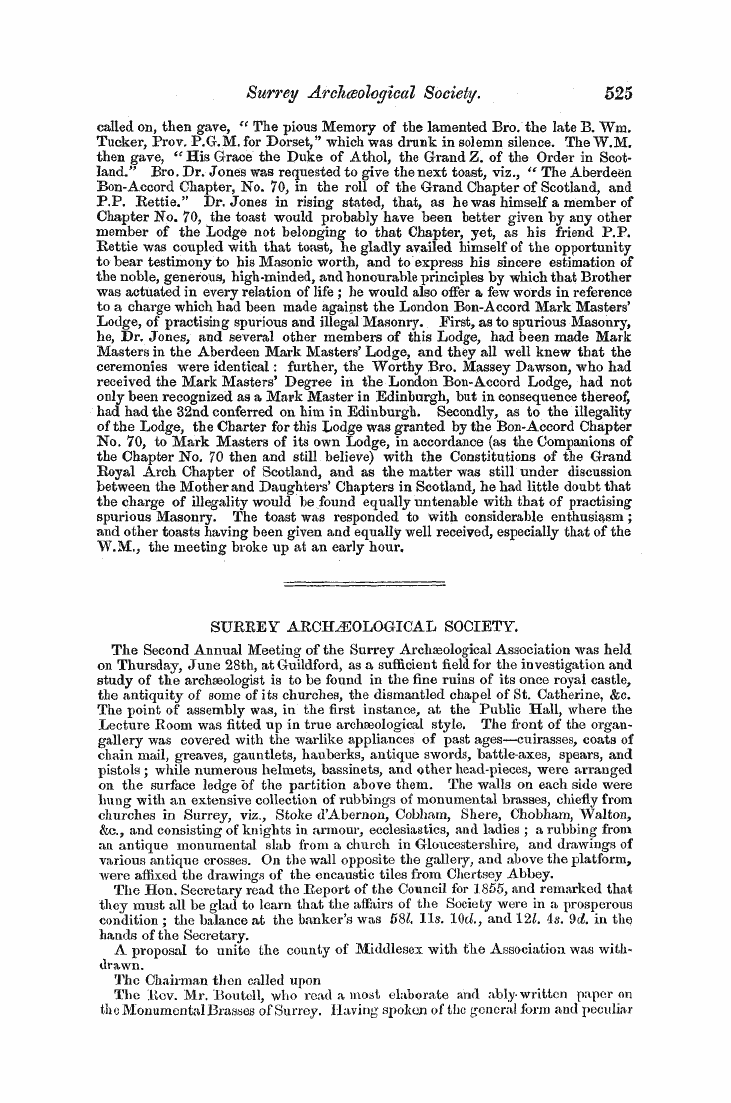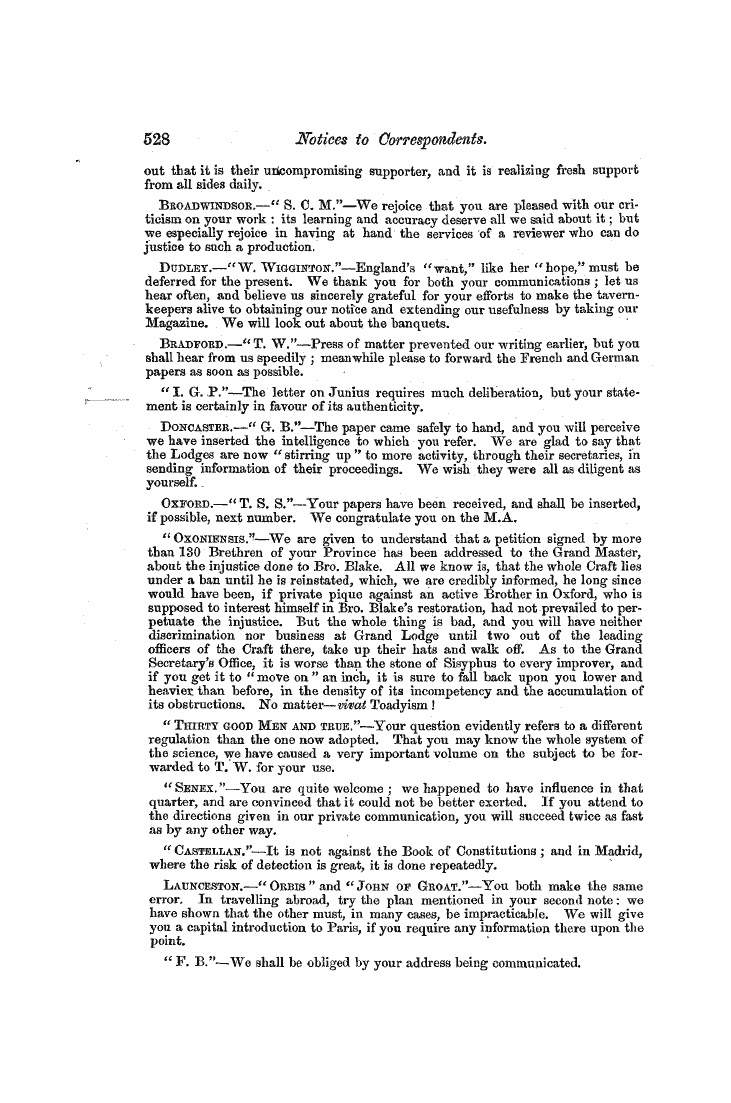-
Articles/Ads
Article Untitled Article ← Page 5 of 7 →
Note: This text has been automatically extracted via Optical Character Recognition (OCR) software.
Untitled Article
in detail is called anatomy . AH animals and vegetables are made up of minute microscopic cells , and these are so arranged as to compose channels or vessels in which fluids can move , and whereby solid matter can be deposited . Minerals have , indeed , a sort of structure , especially those of a crystalline form ; but there are no cells , no
vessels , no circulation , no change of material by means of an organized structure . Organization , then , is the first and most obvious characteristic of living matter . Hence it is called organized matter , and mineral substances are called inorganized matter . The organization of the lower orders of created beings is very simple ; but in the
higher animals it consists of an assemblage of distinct and important organs . Organized structure is , however , in all cases , composed of at least two forms , solid and fluid , and of at least three chemical elements , oxygen , hydrogen , and carbon . Minerals may be solid only , or fluid only , or gaseous only . They may likewise consist of but one element .
2 . Growth , or Reproduction . This is a living property o f organized matter . True it is , that minerals maybe said , in a sense , to grow . A snow-ball grows by being rolled in the snow ; the process of petrifaction in a stream is a kind of mineral growth—growth by accretion . But living beings grow from within , by depositions froja vessels , not from addition of layers to the surface . The tree
grows by taking in fluid from the earth , converting that fluid into sap , and depositing , wherever that sap circulates , atoms of living matter convertible into leaf , flower , stem , & c . So all animals take in nutrient matter as food ; and this is in like manner converted into blood , which blood is constantly adding atoms to the structure , while another set of vessels ( the absorbents ) are taking away , by atoms , the worn-out , effete materials which are no longer serviceable . Living
matter , therefore , is always changing . No man has about him an atom of the structure which twenty years ago he called his body . This is true , though not to the same extent , with regard to the tree ; but in regard to minerals , it is not true at all . So , when life quita the body , the process of reparation ceases ; chemical agents decompose its beautiful structure , and it becomes a mineral , obeying the laws , and , in process of time , assuming the form of inorganic matter .
3 . An inherent Tower of Self-preservation always accompanies life . This is perhaps the most marvellous of the many wonders in vital machinery . Vegetables as well as animals , seeds as well as eggs , have this power . Indeed , every part of each living structure has a degree of power , and evinces a sort of physical solicitude , to protect and preserve the whole . For instance , excessive heat or
cold would destroy any animal or plant ; but there is an inherent power which enables the structure to resist , to a great extent , the evil effects of these agents . The human lungs form a sort of furnace , supplying warmth to the system . In cold weather , they act more briskly and provide more heat ; in hot weather , the respiration is slower , or if it happened to be quickened , perspiration is produced , and this is a rapidly cooling process . Thus the interior of VOL . I . 3 Q
Note: This text has been automatically extracted via Optical Character Recognition (OCR) software.
Untitled Article
in detail is called anatomy . AH animals and vegetables are made up of minute microscopic cells , and these are so arranged as to compose channels or vessels in which fluids can move , and whereby solid matter can be deposited . Minerals have , indeed , a sort of structure , especially those of a crystalline form ; but there are no cells , no
vessels , no circulation , no change of material by means of an organized structure . Organization , then , is the first and most obvious characteristic of living matter . Hence it is called organized matter , and mineral substances are called inorganized matter . The organization of the lower orders of created beings is very simple ; but in the
higher animals it consists of an assemblage of distinct and important organs . Organized structure is , however , in all cases , composed of at least two forms , solid and fluid , and of at least three chemical elements , oxygen , hydrogen , and carbon . Minerals may be solid only , or fluid only , or gaseous only . They may likewise consist of but one element .
2 . Growth , or Reproduction . This is a living property o f organized matter . True it is , that minerals maybe said , in a sense , to grow . A snow-ball grows by being rolled in the snow ; the process of petrifaction in a stream is a kind of mineral growth—growth by accretion . But living beings grow from within , by depositions froja vessels , not from addition of layers to the surface . The tree
grows by taking in fluid from the earth , converting that fluid into sap , and depositing , wherever that sap circulates , atoms of living matter convertible into leaf , flower , stem , & c . So all animals take in nutrient matter as food ; and this is in like manner converted into blood , which blood is constantly adding atoms to the structure , while another set of vessels ( the absorbents ) are taking away , by atoms , the worn-out , effete materials which are no longer serviceable . Living
matter , therefore , is always changing . No man has about him an atom of the structure which twenty years ago he called his body . This is true , though not to the same extent , with regard to the tree ; but in regard to minerals , it is not true at all . So , when life quita the body , the process of reparation ceases ; chemical agents decompose its beautiful structure , and it becomes a mineral , obeying the laws , and , in process of time , assuming the form of inorganic matter .
3 . An inherent Tower of Self-preservation always accompanies life . This is perhaps the most marvellous of the many wonders in vital machinery . Vegetables as well as animals , seeds as well as eggs , have this power . Indeed , every part of each living structure has a degree of power , and evinces a sort of physical solicitude , to protect and preserve the whole . For instance , excessive heat or
cold would destroy any animal or plant ; but there is an inherent power which enables the structure to resist , to a great extent , the evil effects of these agents . The human lungs form a sort of furnace , supplying warmth to the system . In cold weather , they act more briskly and provide more heat ; in hot weather , the respiration is slower , or if it happened to be quickened , perspiration is produced , and this is a rapidly cooling process . Thus the interior of VOL . I . 3 Q































































